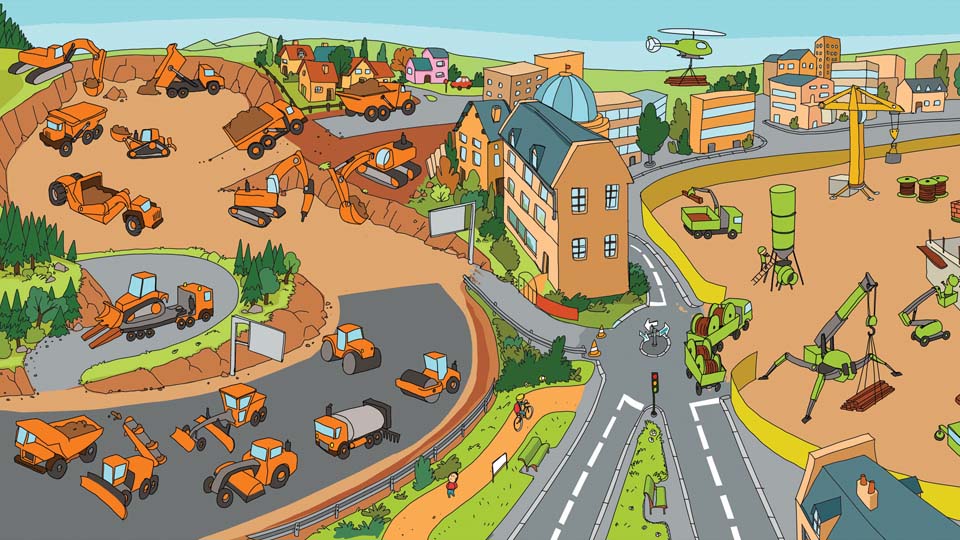For our project "Degrowth from a future perspective", we would like to present how Erik Assadourian , Senior Fellow at the World Watch Institute, envisions a Degrowth America in 2100 and looks back to the transiton towards a truly sustainable United States. Will this have become a place where we can still have personal (electric) vehicles, the latest smart phones and large “eco” homes? Not quite:
By Erik Assadourian
Climate change has had a devastating impact, and it’s not over yet. The total warming of 3.3 to 4.5 degrees Celsius predicted by the Intergovernmental Panel on Climate Change has led to considerable ecological changes. Chicago now has the climate of New Orleans, and New Orleans, well, much of that was claimed by the Gulf of Mexico. The rest of that city, one half of Miami, a third of Manhattan and many other cities were either lost to rising sea levels or proactively converted into wetlands in order to provide a buffer to what habitable land remained. Losing that land was a great tragedy, but a shrinking population, combined with an increasingly agrarian economy made it less painful—in economic terms at least. Nothing will ever replace the loss of the birthplace of jazz.
Perhaps the most striking shift in the United States in 2100 is that a large proportion of Americans now consider their primary occupation to be “homesteaders.” The vast majority live in what were once called “bedroom communities,” suburban infrastructure that was long ago retrofitted into small farmstead communities that provide a secure source of food, textiles and goods both for families living there and the adjacent urban populations. Cities have shrunk in total area and population size as opportunities to become rich dwindled and the security of producing one’s own food became abundantly clear. But cities have also grown denser, with more people living in much smaller homes. The most striking change is the lack of any marginal or underutilized land in cities. Every square foot has its use—to provide shade, food, water filtration, or often a mix of all of these. Nearly every street has a number of urban gardens, parks and artificial wetlands to treat sewage, all managed by a mix of small entrepreneurs and public employees.
With cars nearly all but abandoned, city streets have been redesigned for bikes, pedestrians, pedicabs, taxis, buses, emergency vehicles and delivery trucks—with this small fleet of motorized vehicles running off renewables-derived electricity. Private car travel is still possible but between the extremely high cost and negative social and cultural pressures few people even want to own a car. Instead, vehicle ownership is relegated to car sharing and rental cars for 99% of the population. Much of the Interstate highway system has also been dismantled as the extreme cost of maintaining it was an unmanageable drain on the public coffers. In the most densely populated areas, highway right-of-ways were reassigned for trains and intercity bus rapid transit (BRT) systems. Transport of goods has declined overall, with more food and goods produced locally, but those products without substitution—tea, coffee, spices, high-tech goods—are mainly transported by rail, BRT highways or the rehabilitated canal systems.
Naturally, with dramatic changes in urban design and American lifestyles, entire industry sectors disappeared. The car industry was retooled to make electric buses, trains, taxis and pedicabs. The less competitive and innovative companies—those that failed to read the changing winds—shut down long ago. This shift also contributed to some extent to the shrinking of the coal, oil and natural gas sectors. The largest drivers of this reduction were the fossil fuel taxes implemented in 2019 (and growing ever since) and America’s reduced global military presence. Together these shifts led to a massive contraction of the fossil fuel industry—to about a hundredth of its peak size—and today the sector is state-owned and its products are reserved exclusively for industrial uses that have no effective substitution.
Some argue that we’re regressing to colonial days and in some ways it’s true—most people work in labor-intensive trades like agriculture, education, healthcare, waste recycling, repair, trade and small-scale production of textiles and durable goods. But the gains made since the colonial era in medicine, in human and environmental rights, in planetary science and the arts have not been lost and arguably these aspects of human life flourish more today than ever before.
With fossil fuel usage minimized, and an intentional weaning off of nuclear and the decommissioning of aging and ecologically destructive hydroelectric dams, there is a lot less electricity to go around. Strategic investments in sustainable renewables (solar, wind, small hydro) have replaced much of the nuclear and large hydro lost. An evolution in cultural norms to wear more clothing in the winter and less in the summer in one’s home (not to mention the end of the era of air conditioning)—has made this small amount of electricity feel like more than enough. Electricity usage is further moderated by tiered pricing—the graduation of electricity costs based on the total used. The first 100 kWh a household uses each month are very cheap, perceived as a basic need. The next 100 kWh are quadruple that, with every additional 100 kWh growing ever more expensive. Just the richest few Americans use that kind of electricity. But between new cultural norms, other technologies that take the place of electricity and a simpler life with many fewer gadgets, people get by just fine on just a kWh or two a day.
Biodiversity is recovering to some extent—partly driven by abandoning certain areas of the country and letting nature reclaim them and partly because agriculture is almost entirely sustainable and organic. The government realized that instead of paying companies millions of dollars to log undergrowth in forests to prevent fires, many people would do this for free if granted the ability to live in and subsist off of these ecosystems. These “caretaker communities” now play a vital role in maintaining the health of ecosystems and, as many studies have shown, their presence is actively enriching these systems.
One of the effects of a shift to homesteading and an increasingly informal economy has been the return of multi-generational households. The era of outsourcing elder and childcare came to an end as the total number of jobs shrank and cheap transportation declined but this was readily solved by having elders once again taking care of children while younger adults worked either in remaining formal jobs or around the homestead.
Healthcare also underwent a radical shift over the past century. Some diseases simply disappeared as diets changed and obesity rates went from over two-thirds of the population in 2010 to just over 2% 90 years later. Gone were the vast majority of cases of diabetes, heart disease, many forms of cancer and arthritis.
With more people physically active and eating healthily, medical care focuses more on treating infectious diseases and accidents and teaching people to prevent sickness. Of course, this, too, was not an easy transition. The pharmaceutical industry, making billions on treating the symptoms of unhealthy living, did not go quietly into the night. But as basic access to care finally became a human right in the U.S. and the system became socialized, the government finally had an incentive to refocus the healthcare system on prevention rather than treating symptoms. School food became healthy, junk food became steeply taxed, advertising for unhealthy products and drugs became tightly controlled.
Our diets changed rapidly as cheap fuel and agricultural subsidies dried up. At first, this manifested with the dramatic shrinkage in availability of total number of calories and packaged, processed foods. Over time, total calories increased but the majority came from less calorie-dense, and more nutritional vegetable matter, including a large percentage produced locally either by small-scale farmers or by one’s own family.
One of the biggest changes in 2100 America stemmed from the departure of cheap air travel. This loss (along with comparable increases in other long-distance transportation costs) led to the re-rooting of American families, with most families remaining in the towns, or at least the states, in which they were born. Those that do wander far, driven by their dreams or a desire to start anew, rarely return. But with cultural norms that emphasize familial and community responsibility, this kind of reinvention has become rare. While air travel is uncommon, it has not been altogether abandoned. Instead, it became a sacred rite of passage, with most Americans flying a few times in their lives. Intercontinental travel is now a once-in-a-lifetime luxury, the idea of traveling to another continent for a week of fun and sun, however, was relegated to the history books.
Day to day, things function much the same way as they have throughout history (the 20th century arguably excluded). People get up, do a few errands like milking the goat or collecting eggs, have breakfast, listen to the news on the radio, work on their homestead or head to their job, come home, have dinner with their family, relax—maybe read a book or play a board game that they borrowed from the library, or on special occasions, watch something on the family laptop. One of the most remarkable shifts is that average TV/video consumption has declined from four hours a day to four hours a week.
Admittedly all this adds up to an almost alien world as compared to America in 2012. First and foremost, this vision assumes an ever increasing level of equity—resources better distributed among Americans including employment, land and, most importantly, a fair share of wealth being returned to society by the richest in order to fund public infrastructure and social goods, including a basic level of healthcare for all people. But America is not like that, nor is any country in existence today. Instead, growth in all its forms is celebrated uncritically
More likely, the America of 2100 will have more in common with post-Soviet Tajikistan. Tajikistan in 2012, two decades after the collapse of the Soviet Union, is rabidly inequitable with most people lacking heating in the winter while a small minority lives an affluent consumer lifestyle, complete with iPhones, gym memberships and foreign travel. Much of the infrastructure is old and inefficient Soviet construction—not a comfortable lifestyle for those that can’t afford gas or electricity. Most people eke out a living in the informal economy, but lack any security whatsoever—access to healthcare, a social safety net, even a functioning banking system.
This, sadly, is a more probable path for America, but it is certainly not inevitable. The key to avoiding this, however, will be to have a clear, attainable vision of a truly sustainable society. Even a green consumer lifestyle is directly in conflict with the realities of a finite and increasingly overtaxed planet and is a vision based on denial. Only when people face this reality will a future of true sustainable prosperity for the United States and the planet be possible.
> Comment this artlicle on the German blog "Postwachstum"
New Roots for the Economy: academics, experts, artists, activists and organizations from around the world demand a farewell to our economy's growth dependency to avoid further crises. In the turmoil of the crisis, our everyday lives are being shaken up. We need to reinvent, adapt, organize ourselves. This is also true for the degrowth movement: this crisis has driven us to connect, debate, and...

Degrowth poses a fundamental challenge to a Labour Party that has yet to decide how far it wishes to transcend – and not merely reform – a growth- oriented, capitalist political economy. The British Labour Party has seen a resurgence of radicalism since the 2007-8 financial crash. With the collapse of the authority of neoliberalism, a space has opened for alternative ideologies, theories and...
Shortly before the start of the Climate Camp and the Degrowth Summer School, we are changing the venue of our camp. We have found an even better place in close proximity to the open cast mine Garzweiler. Further information is available here